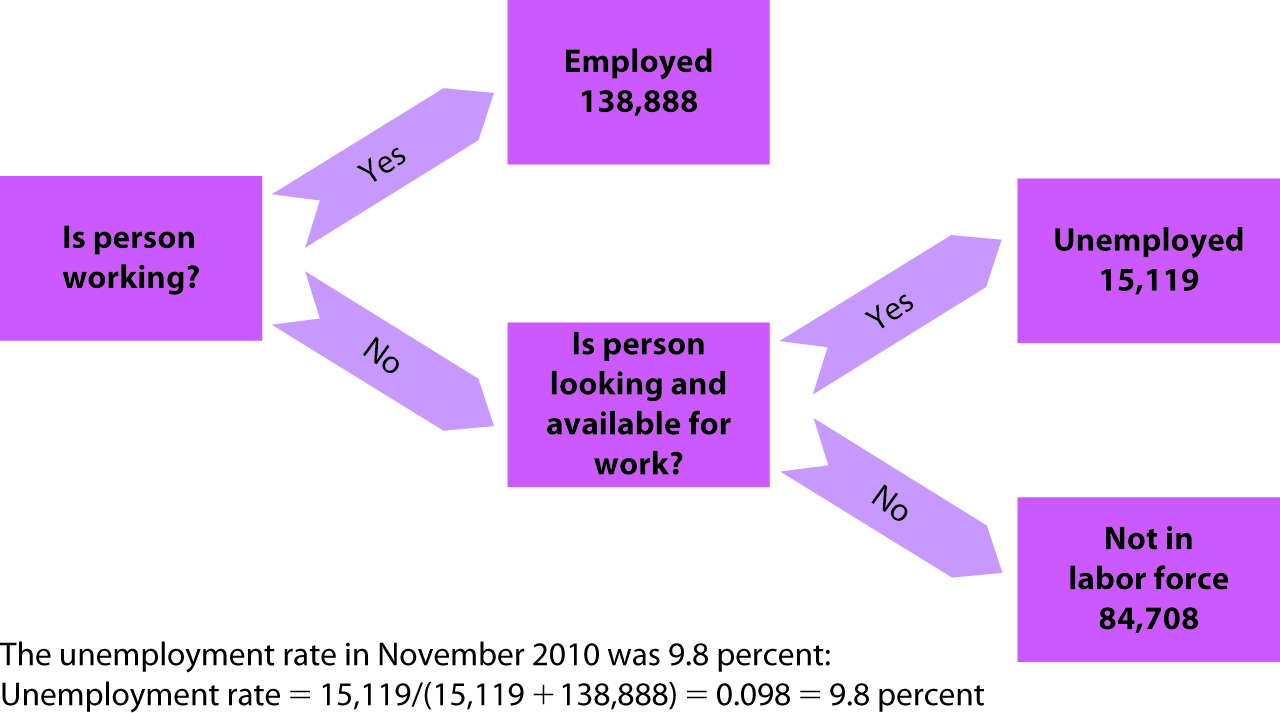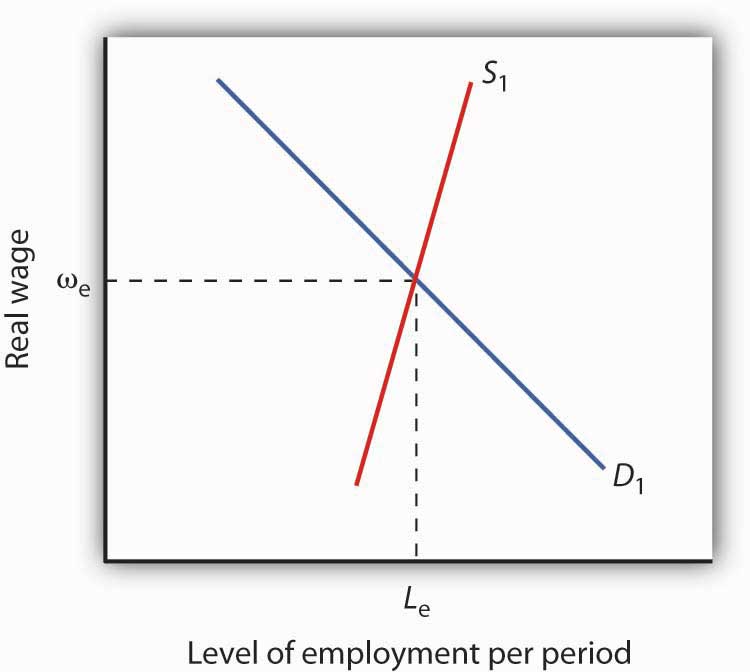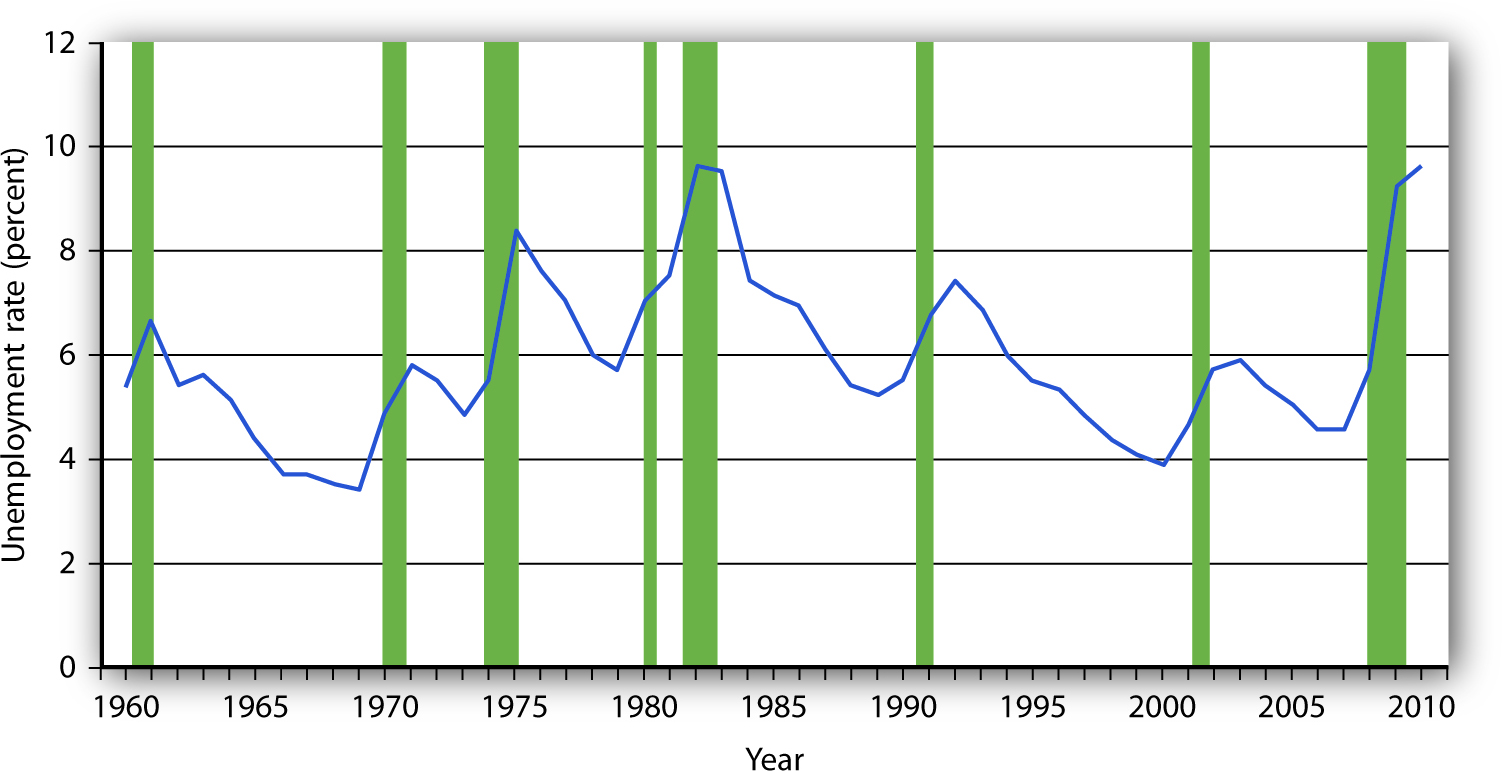8.6 – Unemployment
Learning Objectives
- Explain how unemployment is measured in Canada.
- Define three different types of unemployment.
- Define and illustrate graphically what is meant by the natural level of employment. Relate the natural level of employment to the natural rate of unemployment.
For an economy to produce all it can and achieve a solution on its production possibilities curve, the factors of production in the economy must be fully employed. Failure to fully employ these factors leads to a solution inside the production possibilities curve in which society is not achieving the output it is capable of producing.
In thinking about the employment of society’s factors of production, we place special emphasis on labour. The loss of a job can wipe out a household’s entire income; it is a more compelling human problem than, say, unemployed capital, such as a vacant apartment. In measuring unemployment, we thus focus on labour rather than on capital and natural resources.
Measuring Unemployment
Statistics Canada defines a person as unemployed if he or she is not working but is looking for and available for work. The labour force is the total number of people working or unemployed. The unemployment rate is the percentage of the labour force that is unemployed.
To estimate the unemployment rate, government uses the information they collect in surveys of various Canadian households. At each of these randomly selected households, the surveyor asks about the employment status of each adult (everyone age 15 or over) who lives there. Many households include more than one adult; the survey gathers information on about roughly 100,000 adults. The surveyor asks if each adult is working. If the answer is yes, the person is counted as employed. If the answer is no, the surveyor asks if that person has looked for work at some time during the previous four weeks and is available for work at the time of the survey. If the answer to that question is yes, the person is counted as unemployed. If the answer is no, that person is not counted as a member of the labour force. Figure 8.6a "Computing the Unemployment Rate" shows the survey’s results for the civilian (nonmilitary) population for November 2010. The unemployment rate is then computed as the number of people unemployed divided by the labour force—the sum of the number of people not working but available and looking for work plus the number of people working.

Figure 8.6a Computing the Unemployment Rate
Illustrates the survey results for the civilian (nonmilitary) population for November 2010.
Starting with the question - Is the person working? If yes, Employed: 138, 888.
If no, then is the person looking and available for work? If yes, then Unemployed: 15, 119. If no, then Not in the labour force: 84,708.
The unemployment rate in November 10 2012 was 9.8 percent: Unemployment rate = 15, 119/(15,119 + 138, 888) = 0.0098 = 9.8 percent
A monthly survey of households divides the civilian adult population into three groups. Those who have jobs are counted as employed; those who do not have jobs but are looking for them and are available for work are counted as unemployed; and those who are not working and are not looking for work are not counted as members of the labour force. The unemployment rate equals the number of people looking for work divided by the sum of the number of people looking for work and the number of people employed.
The problem of understating unemployment among women has been fixed, but others remain. A worker who has been cut back to part-time work still counts as employed, even if that worker would prefer to work full time. A person who is out of work, would like to work, has looked for work in the past year, and is available for work, but who has given up looking, is considered a discouraged worker. Discouraged workers are not counted as unemployed, but a tally is kept each month of the number of discouraged workers.
The official measures of employment and unemployment can yield unexpected results. For example, when firms expand output, they may be reluctant to hire additional workers until they can be sure the demand for increased output will be sustained. They may respond first by extending the hours of employees previously reduced to part-time work or by asking full-time personnel to work overtime. None of that will increase employment, because people are simply counted as “employed” if they are working, regardless of how much or how little they are working. In addition, an economic expansion may make discouraged workers more optimistic about job prospects, and they may resume their job searches. Engaging in a search makes them unemployed again—and increases unemployment. Thus, an economic expansion may have little effect initially on employment and may even increase unemployment.
Types of Unemployment
Workers may find themselves unemployed for different reasons. Each source of unemployment has quite different implications, not only for the workers it affects but also for public policy.
Figure 8.6b "The Natural Level of Employment" applies the demand and supply model to the labour market. The price of labour is taken as the real wage, which is the nominal wage divided by the price level; the symbol used to represent the real wage is the Greek letter omega, ω. The supply curve is drawn as upward sloping, though steep, to reflect studies showing that the quantity of labour supplied at any one time is nearly fixed. Thus, an increase in the real wage induces a relatively small increase in the quantity of labour supplied. The demand curve shows the quantity of labour demanded at each real wage. The lower the real wage, the greater the quantity of labour firms will demand. In the case shown here, the real wage, ωe, equals the equilibrium solution defined by the intersection of the demand curve D1 and the supply curve S1. The quantity of labour demanded, Le, equals the quantity supplied. The employment level at which the quantity of labour demanded equals the quantity supplied is called the natural level of employment. It is sometimes referred to as full employment.

Figure 8.6b The Natural Level of Employment (Text Version)
The employment level at which the quantity of labour demanded equals the quantity supplied is called the natural level of employment. The vertical axis is Real wage (W) and horizontal axis is level of employment per period (L). The supply curve (S1) slopes upward from left to right and the demand curve (D1) slopes downward from left to right; S1 and D1 intersect at We and Le. The natural level of employment is Le, which is achieved at a real wage ωe.
Even if the economy is operating at its natural level of employment, there will still be some unemployment. The rate of unemployment consistent with the natural level of employment is called the natural rate of unemployment. Business cycles may generate additional unemployment. We discuss these various sources of unemployment below.
Frictional Unemployment
Even when the quantity of labour demanded equals the quantity of labour supplied, not all employers and potential workers have found each other. Some workers are looking for jobs, and some employers are looking for workers. During the time it takes to match them up, the workers are unemployed. Unemployment that occurs because it takes time for employers and workers to find each other is called frictional unemployment.
The case of college graduates engaged in job searches is a good example of frictional unemployment. Those who did not land a job while still in school will seek work. Most of them will find jobs, but it will take time. During that time, these new graduates will be unemployed. If information about the labour market were costless, firms and potential workers would instantly know everything they needed to know about each other and there would be no need for searches on the part of workers and firms. There would be no frictional unemployment. But information is costly. Job searches are needed to produce this information, and frictional unemployment exists while the searches continue.
Structural Unemployment
Another reason there can be unemployment even if employment equals its natural level stems from potential mismatches between the skills employers seek and the skills potential workers offer. Every worker is different; every job has its special characteristics and requirements. The qualifications of job seekers may not match those that firms require. Even if the number of employees firms demand equals the number of workers available, people whose qualifications do not satisfy what firms are seeking will find themselves without work. Unemployment that results from a mismatch between worker qualifications and the characteristics employers require is called structural unemployment.
Structural unemployment emerges for several reasons. Technological change may make some skills obsolete or require new ones. The widespread introduction of personal computers since the 1980s, for example, has lowered demand for typists who lacked computer skills.
Structural unemployment can occur if too many or too few workers seek training or education that matches job requirements. Students cannot predict precisely how many jobs there will be in a particular category when they graduate, and they are not likely to know how many of their fellow students are training for these jobs. Structural unemployment can easily occur if students guess wrong about how many workers will be needed or how many will be supplied.
Structural unemployment can also result from geographical mismatches. Economic activity may be booming in one region and slumping in another. It will take time for unemployed workers to relocate and find new jobs. And poor or costly transportation may block some urban residents from obtaining jobs only a few miles away.
Public policy responses to structural unemployment generally focus on job training and education to equip workers with the skills firms demand. The government publishes regional labour-market information, helping to inform unemployed workers of where jobs can be found. The North American Free Trade Agreement (NAFTA) which is now called USMCA, created a free trade region encompassing Mexico, the United States, and Canada, has created some structural unemployment in the three countries.
Although government programs may reduce frictional and structural unemployment, they cannot eliminate it. Information in the labour market will always have a cost, and that cost creates frictional unemployment. An economy with changing demands for goods and services, changing technology, and changing production costs will always have some sectors expanding and others contracting—structural unemployment is inevitable. An economy at its natural level of employment will therefore have frictional and structural unemployment.
Cyclical Unemployment
Of course, the economy may not be operating at its natural level of employment, so unemployment may be above or below its natural level. In a later chapter we will explore what happens when the economy generates employment greater or less than the natural level. Cyclical unemployment is unemployment in excess of the unemployment that exists at the natural level of employment.
Figure 8.6c "Unemployment Rate, 1960–2010" shows the unemployment rate in the United States for the period from 1960 through November 2010. We see that it has fluctuated considerably. How much of it corresponds to the natural rate of unemployment varies over time with changing circumstances. For example, in a country with a demographic “bulge” of new entrants into the labour force, frictional unemployment is likely to be high, because it takes the new entrants some time to find their first jobs. This factor alone would raise the natural rate of unemployment. A demographic shift toward more mature workers would lower the natural rate. During recessions, highlighted in Figure 8.6c "Unemployment Rate, 1960–2010", the part of unemployment that is cyclical unemployment grows. The analysis of fluctuations in the unemployment rate, and the government’s responses to them, will occupy center stage in much of the remainder of this book.

Unemployment Rates in Canada
To learn more about unemployment rates in Canada visit Trading Economics Canada's Unemployment Rate [New Tab] webpage.
Key Takeaways
- People who are not working but are looking and available for work at any one time are considered unemployed. The unemployment rate is the percentage of the labour force that is unemployed.
- When the labour market is in equilibrium, employment is at the natural level and the unemployment rate equals the natural rate of unemployment.
- Even if employment is at the natural level, the economy will experience frictional and structural unemployment. Cyclical unemployment is unemployment in excess of that associated with the natural level of employment.
Try It!
Given the data in the table, compute the unemployment rate in Year 1 and in Year 2. Explain why, in this example, both the number of people employed and the unemployment rate increased.
| Year | Number employed (in millions) | Number unemployed (in millions) |
|---|---|---|
| 1 | 20 | 2 |
| 2 | 21 | 2.4 |
Check your answer[1]
Attribution
Except where otherwise noted, this chapter was adapted from "Unemployment" In BUS 400 Business Economics by Sandra Wellman, licensed under CC BY-NC-SA. / A derivative of "Unemployment" In Principles of Economics by University of Minnesota, licensed under CC BY-NC-SA./ Adaptations include removal of case in point section.
Media Attributions
- Computing the Unemployment Rate © University of Minnesota is licensed under a CC BY-SA (Attribution ShareAlike) license
- The Natural Level of Employment © University of Minnesota is licensed under a CC BY-SA (Attribution ShareAlike) license
- Unemployment Rate in the US, 1960–2010 © University of Minnesota is licensed under a CC BY-NC-SA (Attribution NonCommercial ShareAlike) license
- In Year 1 the total labour force includes 22 million workers, and so the unemployment rate is [latex]{\scriptsize\ 2 \div 22 = 9.1\%}[/latex].In Year 2 the total labour force numbers 23.4 million workers; therefore the unemployment rate is [latex]{\scriptsize \; 2.4\div 23.4 = 10.3\%}[/latex].In this example, both the number of people employed and the unemployment rate rose, because more people ([latex]{\scriptsize \; 23.4 − 22 = 1.4 \text{million}}[/latex]) entered the labour force, of whom 1 million found jobs and 0.4 million were still looking for jobs. ↵
The percentage of adults who are in the labor force and thus seeking jobs, but who do not have jobs
Those who have stopped looking for employment due to the lack of suitable positions available
Unemployment that occurs as workers move between jobs

